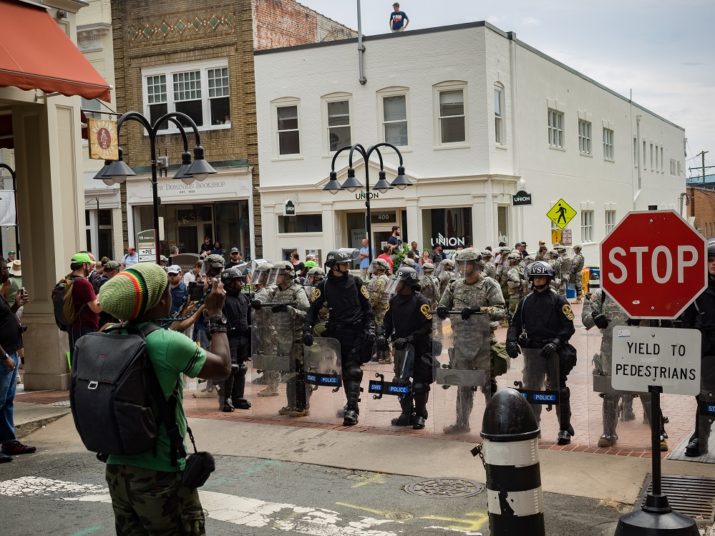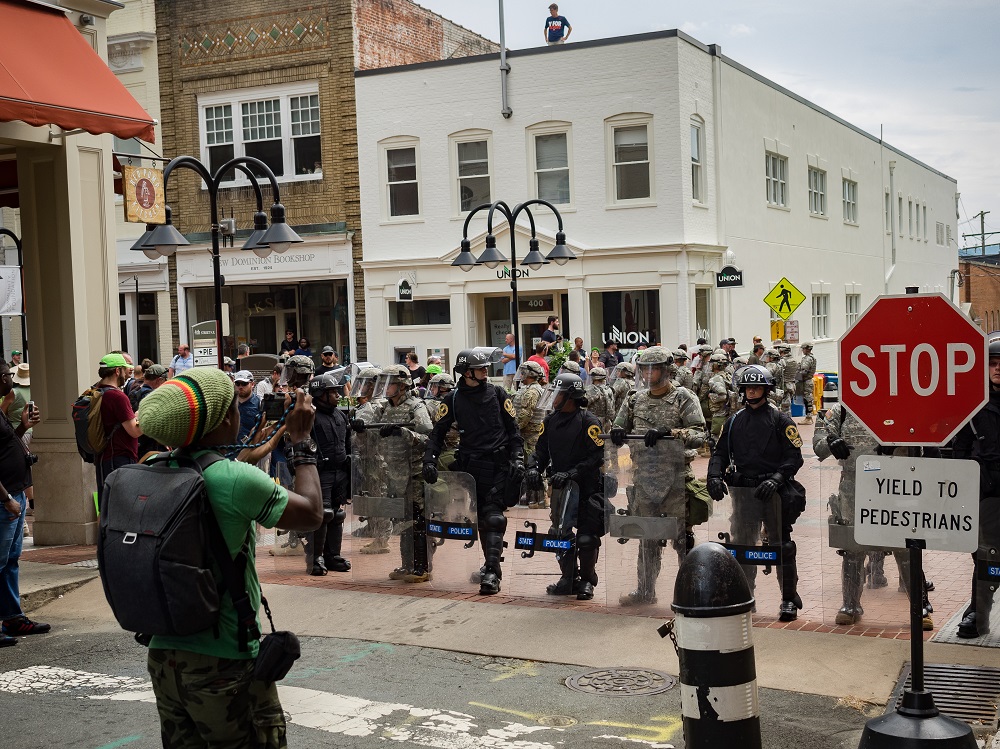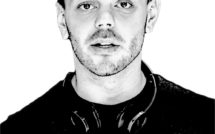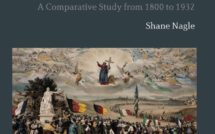

This is part of our Campus Spotlight on the University of Virginia.
Translated by Jeffrey Grossman.
Three months after the Nazi march and terror attack in Charlottesville, a film that seeks to unearth what exactly happened there on August 12, 2017 celebrated its premiere in the very same place.The film, directed by Brian Wimer and Jackson Landers, is called Charlottesville: Our Streets.
Visitors to Charlottesville are easy to recognize these days: they carry cameras and head for Emancipation Park—the small park in the middle of which stands the statue of General Robert E. Lee astride his rearing steed. Yet, those who go there now see – nothing. The statue is covered with a black plastic tarp, like old worn out bronze pieces left in a publicly accessible broom closet.
Six pillars display the words: “No Trespassing: City Personnel Only.” Someone has pasted flyers to the metal posts, announcements for “African Drumming.” Next to them hangs a lonely sticker: “Antifascist Action.” An evergreen wreath with the inscription “Veterans” pays homage to the U.S. Army, 1830-1861, and is displayed right at the foot of the black plastic tarp. The inscription refers to the Civil War when the Confederate States tried to secede from the country. The Union army of the North was victorious, ringing in the end of slavery. Robert E. Lee was a commander in the Confederate Army.
The Virginia Film Festival took place in Charlottesville this past November for the thirtieth time. This year, the prominent American director Spike Lee attended the festival. There he screened Four Little Girls (1997), his film about racism and segregation. The director’s presence became a symbol for the city of 60,000 inhabitants, which itself became a hashtag after the events of August 12.
Because the inhabitants of Charlottesville had decided that their central park, a stone’s throw from the city’s main pedestrian zone (“The Downtown Mall”), should not be adorned by a symbol of slavery like the statue of Robert E. Lee, this quiet city became the scene of violent conflict last August. Already in May and July, the right-wing extremist “Alt-Right” movement had mobilized followers from across the country to come to Charlottesville and protest the removal of the statue. Then, in August, hundreds of white supremacists and neo-Nazis dressed in the white costumes of the Ku Klux Klan, their faces exposed and torches in hand, descended upon Charlottesville, chanting racist and antisemitic slogans.
Many people were seriously injured when, on August 12, 2017, the twenty-year old neo-Nazi James Alex Fields drove his car into a crowd of counter-demonstrators, one of whom, Heather Heyer, he killed. At the corner of Water Street and 4th Street, a bed of flowers commemorates Heather Heyer. Later on, two policemen also died when their helicopter crashed.
Charlottesville’s—now former—mayor Michael Signer and former vice mayor Wes Bellamy had tried by legal means to prevent the “Alt-Right” rally from entering into the city’s downtown—in vain. The two of them—one Jewish, the other African-American, both representatives of the Charlottesville citizenry—had stood for a democratic program in this very liberal university town, where they had many issues to tackle. Afterwards, both mayor and vice mayor came under attack.
No one in Charlottesville would ever have thought their city would become a national and, indeed, international symbol. A hair-stylist named Natalie, who had moved here from Chicago, told me back in May: “There are a few diehard right-wingers who demonstrate against the removal of the statue. But that has no significance; they are completely isolated.” Architecture student John S. thought the statue belonged in a museum “but not here in a public space. He was a racist. Why should we have monuments that glorify slavery?” After the events of August 12, students on the University of Virginia campus covered the monument to Thomas Jefferson located there. Jefferson, to be sure, had composed the phrase “all men are created equal” in the Declaration of Independence, but he, himself, remained a slaveholder and had taken as his lover the slave Sally Hemings when she was around fourteen years old or so. The citizens of Charlottesville have wanted to view their city as a kind of paradise, even with this past, as a place where they, as the journalist Jackson Landers says, allow the children to go out alone on the Downtown Mall.
At the Film Festival Landers is responsible for the script of the documentary, Charlottesville: Our Streets, the screening of which turned into its most important event. The film’s title resonates with the slogan of the Black-Lives-Matter movement: “Whose Streets? Our Streets!” The premier at the Paramount Theater, which seats 1,040 people, is sold out. A long line to get into the cinema begins forming an hour before the start of the film. To enter one passes three security checkpoints and bag inspections.
Director Brian Wimer and Jackson Landers worked together with journalist Natalie Jacobsen to complete the interviews and editing of the film in just two months. The material comes not only from Brian Wimer, but also from video recordings made by people in Charlottesville themselves. To that end, the filmmakers viewed and evaluated more than one hundred hours of video material, spoke with thirty witnesses, and decided to trace the events of this one day in August 2017—the 12th—as precisely as possible. The film is still, in many ways, a work in progress. With this screening, the filmmakers will reach many more people who may have additional material to provide. Wesley Harris, the Virginia Film Festival Programmer, says before the film begins that one can at any time leave the theater, that one may have to take care of one’s neighbor, but that the festival has made every effort to make this film possible—so that the people of Charlottesville could write their history and judge for themselves what took place here.
A staggering panopticon of right-wing extremist and right-wing affiliated groups rolls out on the screen: from racists, Ku Klux Klan members, and antisemites to a heavily armed militia and uniformed coal-miners from West Virginia who define themselves as socialists. An activist from the Anti-fascist (antifa) Action speaks, first aid providers, African-Americans, a broad religiously-oriented resistance: “We are ready to die,” says one preacher before the group of counter-demonstrators bursts into song. Someone speaks from within the ranks of the right-wing extremists. In the theater, people call out: “No platform for Nazis!”
During the podium discussion that follows, Brian Wimer says he did not want to judge. He wanted to know what exactly happened. What was done by whom and when. He wanted to leave the door open. Where were the police? Why didn’t they protect people? What orders the state police had, no one knows to this day. Don Gathers, who belongs to the religiously-oriented resistance, demands that personnel face consequences. And he wants to know how people can in future protect themselves from this kind of invasion.
Katrina Turner, from the African-American constituency, repeats a sentence several times: “That white people protected us,” she says, “that white people protected us . . .” She is not the only one on this podium whose voice breaks. Sarah McConnell, a radio producer and journalist, says: “This thing continues to hurt us emotionally and financially, but it was good to see what happened afterwards in Boston, when the “Alt-Right” tried to march there. 30,000 people chased them way.”
This article was originally published in German in die tageszeitung, Berlin, 11.16.2017 and has been slightly revised. It is reprinted with the kind permission of die taz / tageszeitung.
Esther Dischereit, described by her publisher, Suhrkamp Verlag, as “possibly the preeminent German-Jewish voice of the post-Shoah generation,” lives in Berlin. She has published fiction, poetry and essays, as well as plays for radio and the stage. She is the founder of the avant-garde-project WordMusic and has worked as a curator for various projects in contemporary art/new media.
Jeffrey Grossman is Associate Professor and Chair of the German Department and a member of the Jewish Studies program at UVA. His research focuses on Jewish-German relations, with special focus on Yiddish, and on translation and transmission, more generally, of literature and thought. He is currently writing a book about German-Yiddish literary and cultural interaction in the early twentieth century, a portion of which appears in his article “The Yiddish-German Connection: New Directions,” Poetics Today 36:1.2 (June 2015).
** Note: the original article says that Jefferson started the affair with Hemings when she was 13. According to https://www.encyclopediavirginia.org/Hemings_Sally_1773-1835 and other sources, it did not begin before she arrived with his daughter, Polly, in Paris, i.e. age 14.
Photo: Christian W. McMillen | Flickr
Published on February 1, 2018




